 Author: Eiji OKUBO Sales Network: Amazon.com / Amazon.co.jp |
| Written by Eiji Okubo, Printed books and e-books Heritage of Minoan and Mycenaean civilizations Detailed data on Ruins and Excavated items |
| The World of Crafts and Arts of the Minoan & Mycenaean Civilizations "Fresco" |
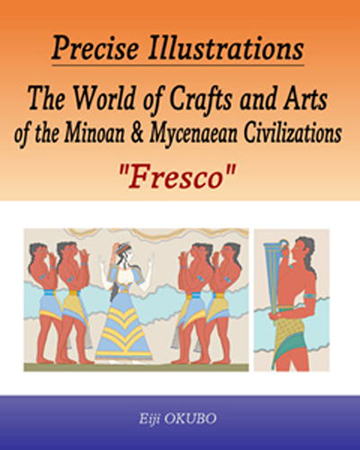 |
| subtitle: Data and explanations of excavated items language: English format: Paperback printing paper: Non-glossy high-quality paper printing ink: High-saturation premium ink size: 8in.x10in. (203mm x 254mm) 215 pages sales: Amazon Network / Amazon.com / Amazon.co.uk |
| Sumary: This book is 8in. x 10in. (203mm x 254mm) version, 210 pages, a “Precision Illustrations & Data Book” of excavated items from the prehistoric Minoan and Mycenaean civilizations in the Aegean Sea. This book contains the most outstanding Frescoes, among the major artifacts excavated from the Knossos Palace ruins on Crete, other Minoan civilization ruins, and the Mycenae Palace ruins, and other important Mycenaean civilization ruins on mainland Greece. This book has picked up 60 of Frescoes, as well as 120 of ruins photographs and related excavated items. Most of the Frescoes explained are Precise Illustrations, and the rest are shown as Photographs. This book will invite you to the "World of Crafts and Arts" of the Minoan and Mycenaean civilizations through carefully selected important works among the excavated items on display at the Heraklion Archaeological Museum in Crete, the National Archaeological Museum of Athens, and other archaeological museums throughout in Greece. Contents: I What are the Minoan civilization and Mycenaean civilizations? II Frescoes of the Minoan and Mycenaean civilizations III Fresco/Figure and Goddess IV Fresco/Animal an Marine Life V Fresco/Plant VI Fresco/Abstract and Geometric |
| Sample Page:(excerpt) ---------- III-01 Minoan Fresco: “Ladies in Blue” 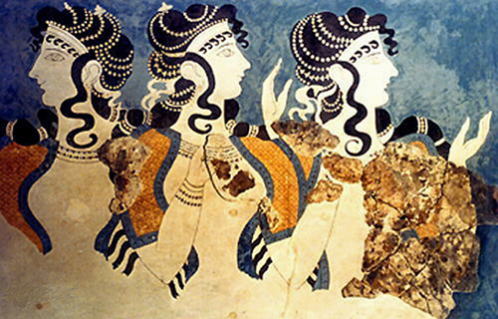 Site: Loom Weight Basement, East Wing, Knossos Palace hape & Decoration: Fresco “Ladies in Blue,” three noble ladies of Knossos Palace, blue background Era: MMIIIA-LMIA, 1625-1500 BC Museum: HAM restoration by Swiss archaeological artist Émile Gilliéron Local: Central North, Crete Photo: 1994 Creating a gorgeous atmosphere: with long and curly hair adorned with elegant hair ornaments, thin eyebrows, and dignified yet clean faces, trendy luxurious necklaces and bracelets which directly imported from Alexandria of Egypt where an advanced country, overly large busts, and innovatively designed Minoan woven costumes sewn for the first time in history - - - The noble women of Knossos Palace who behaving elegantly against a blue background reminiscent of the Aegean Sea. Related: “Loom Weight Basement,” Knossos Palace 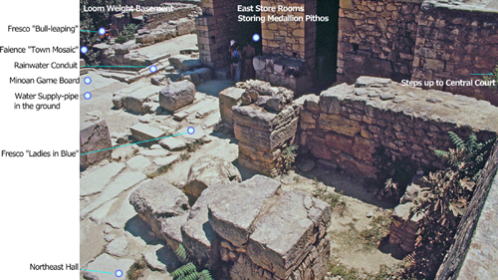 Site: Loom Weight Basement, East Wing, Knossos Palace Situation: Excavation spots of many important items: a) Fresco “Ladies in Blue” and “Bull leaping” b) Faience “Town Mosaic,” Minoan “Royal Game Board” c) Stone rainwater conduit, Water supply-pipe d) many Storing pithoi Era: New Palace Era and Old Palace Era a) mainly remains: New Palace Era, MMIIIA-LMIIIA1, 1625-1375 BC b) partially remains: Old Palace Era, MMIB-LMIIIA1, 1900-1625 BC Local: Central North, Crete Photo: 1982 A large number of valuable excavated items representing the crafts of the Minoan civilization were discovered from remains of the East Wing of the Knossos Palace, known as the "Loom Weight Basement." These items had fallen from the noble halls and rooms on the upper floor during a great fire around 1375 BC when the Knossos Palace finally collapsed. And Sir Arthur John Evans' excavations uncovered several terracotta warp weights for weaving luxury textiles for noble women in this section. Related: Mycenaean Gold Signet Ring, “Noble Women” motif  Site: Chamber Tomb 55, Lower Town, Mycenae Shape & Decoration: Gold Signet Ring, arm (hoop)=granulation technique Epiphany: three goddesses or women with flowers, shrine and scared tree Era: LHII-LHIIIA1, 1500-1375 BC Museum: NAM, inv. No. 2853 / L25mm Local: Argolis, Peloponnese Drawing: Eiji OKUBO III-02 Minoan Fresco: “Princess and Minoan Youth” 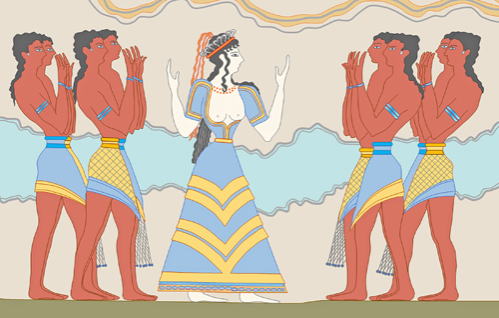 Site: Corridor of Procession Fresco, Southwest Wing, Knossos Palace Shape & Decoration: Fresco “Princess and Minoan youth” of “Procession Fresco” The princess wears an ivory tiara and a thick, luxuriously sewn skirt with the characteristic “V”-shaped pattern of the Minoan civilization. Era: MMIIIA-LMIB, 1625-1450 BC Museum: HAM Local: Central North, Crete Drawing: Eiji OKUBO A Minoan princess with a vermilion hair ornament and an ivory tiara wears a thick, luxuriously sewn skirt with the characteristic "V" pattern of Minoan civilization. Young men, on the other hand, wear traditional loincloths and blue sapphire armlets on their arms. The princess has her palms facing her, while the men are showing respect by pointing their palms toward her. III-13 Mycenaean Fresco: “Noble Mycenaean Lady” 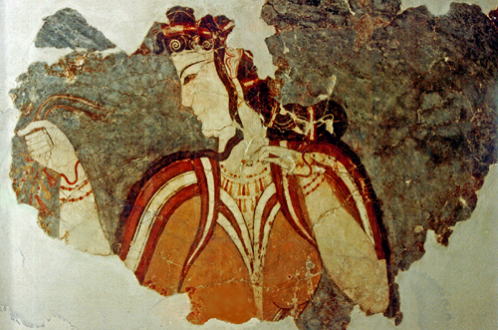 Site: Shrine, Royal Sanctuary, Mycenae Palace Shape & Decoration: Fresco “Noble Mycenaean Lady” Era: LHIIIB, ca. 1250 BC Museum: NAM, inv. No. 11670 / right thumb to left elbow: about 45cm Local: Argolis, Peloponnese Photo: 1987 Related: Mycenaean Rock-crystal Vase, one of noble Women's cosmetics 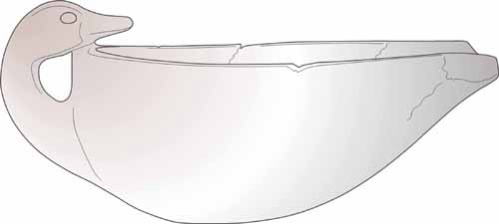 Site: Shaft Grave O, GCB, Mycenae Shape & Decoration: Rock-crystal vase, Duck shaped with spout for cosmetics imported from Minoan Crete? Era: MHIII, ca. 1600 BC Museum: NAM, inv. No. 8638, L132mm mouth height H42mm, head height H47mm Local: Argolis, Peloponnese Drawing: Eiji OKUBO III-14 Mycenaean Fresco: “Noble Mycenaean Lady” 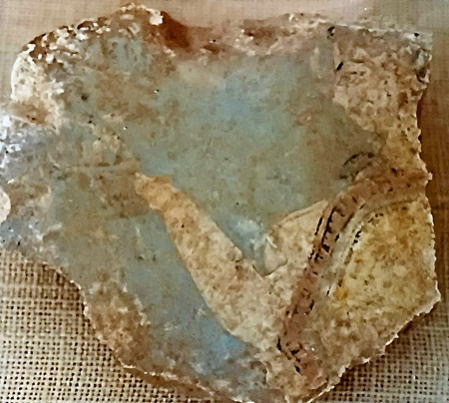 Site: Citadel, Nestor’s Palace Shape & Decoration: Fresco “Noble Mycenaean Lady” Era: LHIIIB, 1300-1200 BC Museum: CHAM Local: Messenia, Peloponnese Photo: 1982 III-15 Mycenaean Fresco: “Ladies in Chariot” 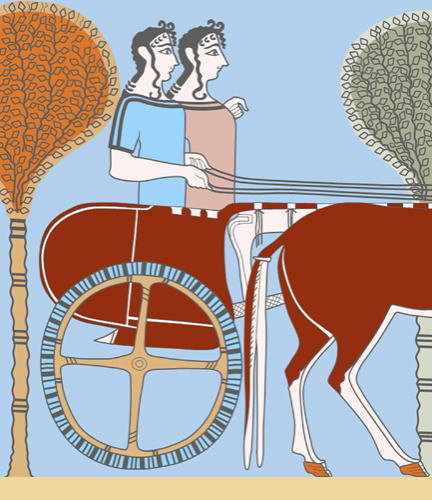 Site: King’s Room, Megaron Complex, Tiryns Palace Shape & Decoration: Fresco “Ladies in Chariot” Era: LHIIIB, 1300-1200 BC Museum: NAM, inv. No. 5882 Local: Argolis, Peloponnese Drawing: Eiji OKUBO Related: Mycenaean Gold Signet Ring: “Chariot” motif 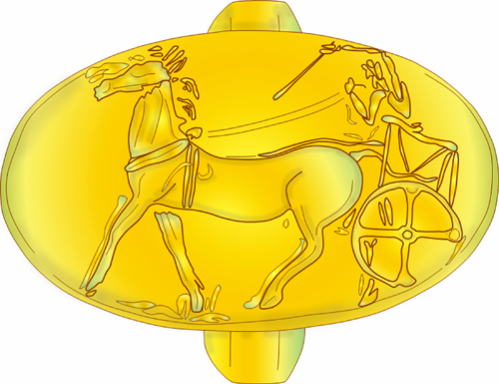 Site: Chamber Tomb 7, Aidonia, near Nemea Shape & Decoration: Gold Signet Ring, “Treasure of Aidonia” two-wheeled chariot and a man Era: LHI-LHII, ca.1500 BC Museum: NEAM, inv. No. 1005 / L33.5mm Local: Corinthia, Peloponnese / 20 km northwest of Mycenae Palace Drawing: Eiji OKUBO GPS: 37°50’25’’N 22°34’59’’E / ALT 355m III-12 Mycenaean Fresco: “Minoan Goddess” 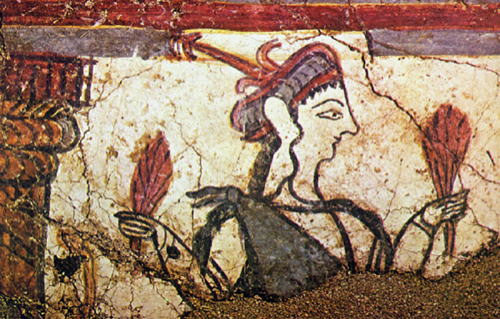 Site: Room of the Fresco, Royal Sanctuary, Mycenae Palace Shape & Decoration: Fresco “Minoan Goddess with sheaves of grain” Era: LHIIIB, ca. 1250 BC Museum: NFAM / right index finger to left index finger: about 26cm Local: Argolis, Peloponnese Photo: 1982 Related: Royal Sanctuary & Shrine, Mycenae Palace 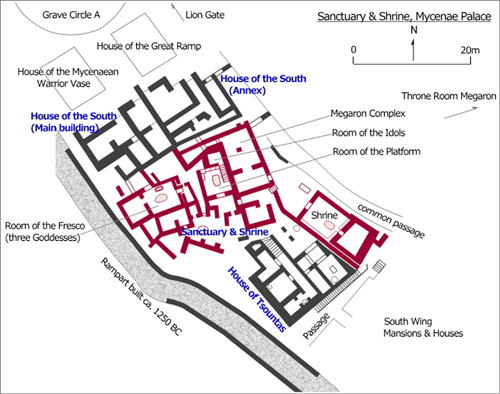 Site: Plan of Royal Sanctuary & Shrine, Mycenae Palace a) House of the Great Ramp b) House of the Mycenaean Warrior Vase c) House of the South, Main Building and Annex d) Royal Sanctuary and Shrine e) House of Tsountas Era: Sanctuary construction: LHIIIB2, ca. 1250 BC Local: Argolis, Peloponnese Drawing: Eiji OKUBO III-28 Mycenaean Fresco: “Soldier or Hunter” 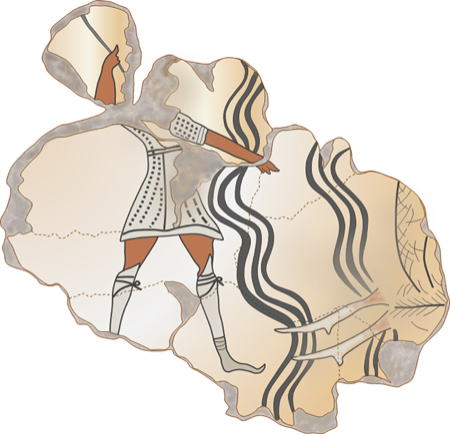 Site: Palace area, Nestor’s Palace Shape & Decoration: Fresco “Mycenaean Soldier” or “Hunter” simple corset-style combat uniform with no tassels at hem, pointed lace-up boots, long shin covers from ankles to above knees and laces, wavy patterns is a river or a simple pattern? two legs of fallen enemy soldier? Era: LHIIIB, 1300-1200 BC Museum: CHAM Local: Messenia, Peloponnese Drawing: Eiji OKUBO III-26 Minoan Stone Sarcophagus Fresco, “Funeral Scene” 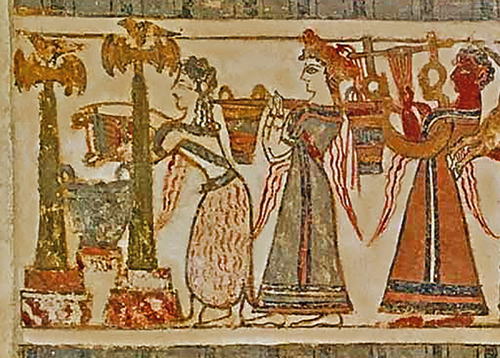 Site: Circular Tomb B, Agia Triada Shape & Decoration: Limestone Sarcophagus Fresco, “Funeral Scene” for male royal member Enlarge drawing=two large double axes with doves, sheepskin skirt female funeral staff pouring sacrificial bull blood by tilting vase, royal woman in a luxurious outfit with a tiara and hair ornament carrying two vessels with blood, long skirt musician playing 7-string lyre Era: LMIIIA2, 1375-1300 BC Museum: HAM, inv. No. 396 / L1,375mm Local: Messara Plain, Crete Photo: 1996 IV-01 Minoan Fresco: “Wild Cat aiming for Pheasant” 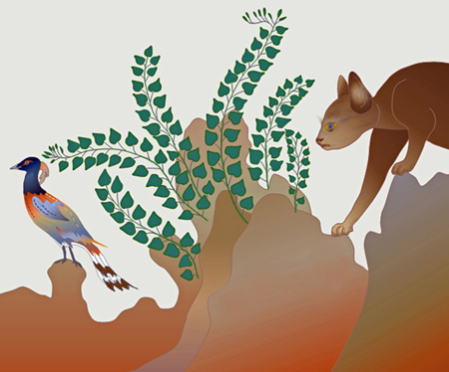 Site: Room of the Fresco, Agia Triada Shape & Decoration: Fresco “Wild Cat aiming for pheasant” in rocky area with ivy Era: LMIA-LMIB, 1550-1450 BC Museum: HAM / L40cm, W40cm Local: Messara Plain, Crete Drawing: Eiji OKUBO Related: Site of Agia Triada, Quasi-palace and Minoan town 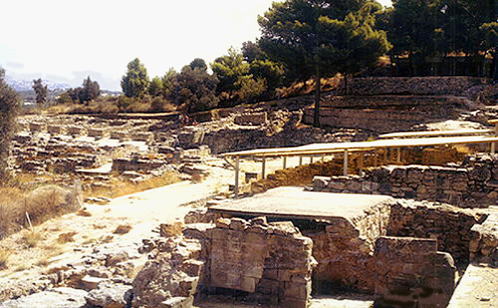 Site: Quasi-palace quarter and Minoan Town, Agia Triada a) plastic protective roof=Quasi-palace area, stone bench’s room, pithos storage b) front=around the concrete protective roof, Quasi-Palace area, Main room, Room of fresco c) far left=Minoan Town, house wall remains, workshops with orderly pillar walls Era: Minoan Era to Sub-Minoan Era a) Minoan civilization=MMIII-LMIB, 1600-1450 BC b) Period of “Occupier Mycenaeans” rule to Sub-Minoan civilization=LMIIIA-LMIIIC, 1400-1100 BC Local: Messara Plain, Crete / 2km west from Phaestos Palace Photo: 1982 GPS: 35°03'33''N 24°47'35''E / ALT 35m IV-07 Mycenaean Fresco: “Goat-headed Daemons”  Site: House of Tsountas, Citadel, Mycenae Palace Shape & Decoration: Fresco “Goat-headed Daemons carrying palanquin poles” Era: LHIIIA2-LHIIIB1, 1375-1250 BC Museum: NAM, inv. No. 2665 / L100mm Local: Argolis, Peloponnese Drawing: Eiji OKUBO ---------- |